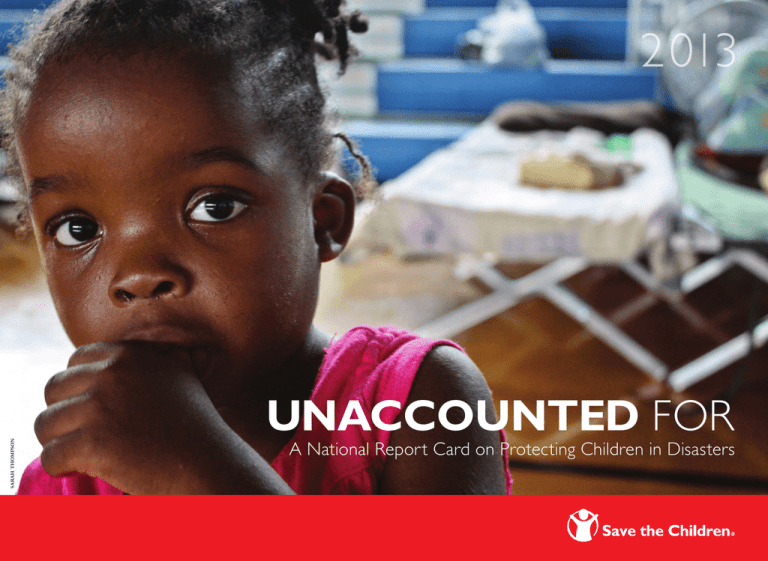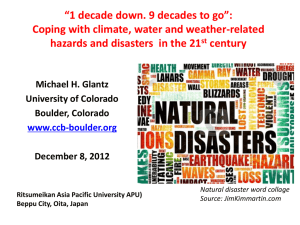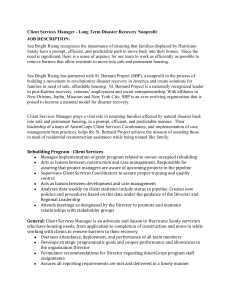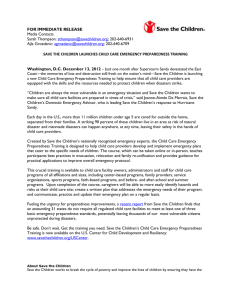UNACCOUNTED A National Report Card on Protecting Children in Disasters n
advertisement

sarah thompson UNACCOUNTED FOR A National Report Card on Protecting Children in Disasters For 80 years Save the Children has been working to help American children in greatest need. This past year has shown us like never before that every American child needs better protection from disasters that can strike anywhere at anytime. We’re committed to moving children to the center of our nation’s emergency preparedness, response and recovery. “Mama, when will we go home? When can I go back to school? ” RIGHT: Oct. 29-31, 2012 Hurricane Sandy lands, tears through 24 states: kills 162, uproots thousands of NY and NJ families. $50 billion in damages include 650,000 homes, hundreds of child care centers and schools. ON THE COVER: Aug. 28-Sept. 1, 2012 Hurricane Isaac batters the Gulf Coast, leaving many families homeless for the second time since Hurricane Katrina. Ray’iona, 3, at a shelter in Kentwood, LA. ICONS INDICATE ADDITIONAL CONTENT AVAILABLE AT SAVETHECHILDREN.ORG/DISASTER2013 STORY VIDEO ALL PHOTOS BY SUSAN WARNER, EXCEPT WHERE NOTED. 2 – Saif, 4, to his mom after Sandy gutted their first-floor Brooklyn apartment and his Head Start classroom. Children were the face of a record year of disaster… America’s 2013 National Report Card on Protecting Children in Disasters: UNSATISFACTORY GAPS IN PREPAREDNESS PUT CHILDREN AT RISK BEFORE DISASTER STRIKES: • 28 states and the District of Columbia still fail to meet minimum standards to protect children recommended by the National Commission on Children and Disasters. • 17 states don’t require child care providers to have an evacuation plan. • 16 states don’t require child care providers to have a family reunification plan. • 24 states don’t require child care providers to have a plan for children with disabilities or with access and functional needs. 68 million children are separated from their parents every workday. But 28 states still don’t meet basic emergency planning standards for schools and child care. • 6 states and the District of Columbia don’t require schools to have a disaster plan that addresses multiple types of hazards. Ü See the report card on page 10 for state-by-state results. • Schools and child care centers are often not required to practice emergency plans regularly. • Families are often not well-informed about reunification plans or asked to update emergency contact information. • Emergency responders often have no official registry of child care centers to facilitate plans to reach all children. • State and community emergency plans often fail to adequately account for the needs of children. reuters / adam hunger courtesy trust.org / alertnet 3 GAPS IN RESPONSE MEAN CHILDREN TAKE REFUGE IN SHELTERS THAT MAY HAVE: • No mandate to count number of children taking refuge. • Not enough food for children. • No basic supplies for babies and children. • N o designated areas or bathrooms for children and families to protect children from injury or exploitation. • N o safe places for children to play, emotionally recover or be cared for while families begin to rebuild. GAPS IN RECOVERY ENDANGER CHILDREN’S LONG-TERM CAPACITY TO REBOUND: • C hild care centers have limited or no access to federal recovery funds. • M any children are unable to go back to child care programs, which can delay their development and keep parents from going back to work. • C hildren often lack specialized support to heal from the trauma, fear and stress they have experienced. “Children were sleeping in the same room as rival gang members.” — Amy Richmond, Save the Children child protection officer in Sandy shelters ABOVE: May 20, 2013 tornadoes rip through Moore, OK: 3 schools destroyed, 57 schools damaged, 1,248 homes leveled. RIGHT: Dec. 14, 2012 Sandy Hook Elementary School in Newtown, CT attacked: 20 children and 6 educators killed, a nation shaken. 4 getty images / justin clemons “It took six months for the last child to be reunited with her family after Hurricane Katrina. We need to make sure this never happens again.” – Carolyn Miles, President & CEO, Save the Children …but they are often unaccounted for in emergencies. “We never thought kissing Emilie goodbye that day would be the last time we’d see her. Our hope now is that people will rally around school safety so we can save other children’s lives.” – Robbie Parker, pictured with his wife Alissa, holding a picture of their daughter, Emilie, 6, who was killed at Sandy Hook Elementary School. 5 It’s time to protect children by… “If nothing changes out of this, then something is wrong.” – Jennifer Stoltz, Sandy Hook parent – Alissa Parker, Sandy Hook parent RIGHT: Schoolchildren test whistles from Save the Children-provided backpacks during a 2007 disaster preparedness program in Tulsa, OK. 6 michael wyke / tulsa world “Even if drills are held regularly, it’s important to look for gaps in preparedness. One of the most stressful things that day was reunification. We were told by three different people to look for our daughter at three different places.The chaos made it so much worse for all of us.” “What saved the children was that the teachers had practiced their drills so many times they didn’t need to think what to do when the tornado hit. They just reacted.” – Abby Larsen, owner and director of A Step Above Learning Center, now relocated to Moore, OK. When the tornado destroyed the center’s Oklahoma City building, none of the 23 children, teachers or parents inside were seriously injured. ABOVE: Ryleigh and Paige, both 3, back safe and sound at the All About Kids Learning Center in Moore, OK. The well-prepared center kept 162 kids and adults from harm when the May tornado struck. ...creating, communicating and practicing strong plans. 7 ...creating and rebuilding safe places for children. “Disaster evacuations are stressful times for families, especially children.When Save the Children opens a Child-Friendly Space in a shelter, children have a place where they can play and smile again even as other family members are working nearby on ways to recover and return home.” – Gail J. McGovern, President and CEO, American Red Cross 8 “It’s important to the kids because then they know how to feel better and be strong and calm down easily.” – Anthony, 7, on how Save the Children’s Journey of Hope program is helping after Hurricane Sandy. ...helping children recover in the long and short term. ABOVE AND LEFT: Didi, 4, at a Save the Children Child-Friendly Space in an Atlantic City shelter after Hurricane Sandy. 9 2013 NATIONAL REPORT CARD The presidentially-appointed National Commission on Children and Disasters was formed after Hurricane Katrina and led by Save the Children. The commission’s 2010 final recommendations included four state standards essential for basic disaster preparedness and safety in schools and child care facilities. Save the Children annually commissions research on regulations and child care licensing laws for all 50 states and the District of Columbia to determine how well-prepared child care facilities and K-12 schools are to respond to the needs of children in the event of disasters and emergencies. The number of states that meet all four standards has increased from four in 2008 to 22 in 2013. Research was conducted by Brown Buckley Tucker and reflects action in relevant state administrative offices and state legislatures as of July 2013. * Regulations are under revision and a draft of the proposed regulations was reviewed and met criteria. 10 STANDARDS MET STATE EVACUATION/ RELOCATION PLAN FAMILY-CHILD REUNIFICATION PLAN CHILDREN WITH SPECIAL NEEDS PLAN K–12 MULTIPLE DISASTER PLAN Alabama Arkansas California Connecticut Hawaii Kentucky Louisiana Maryland Massachusetts Mississippi Nebraska New Hampshire New Jersey* New Mexico New York Tennessee Utah Vermont Washington West Virginia Wisconsin Wyoming • • • • • • • • • • • • • • • • • • • • • • • • • • • • • • • • • • • • • • • • • • • • • • • • • • • • • • • • • • • • • • • • • • • • • • • • • • • • • • • • • • • • • • • • 3 Alaska Delaware District of Columbia Missouri North Carolina Ohio Oklahoma Pennsylvania Texas Virginia • • • • • • • • • • • • • • • • • • • • • • • • 2 Colorado • Florida • Indiana • Minnesota • Nevada • Rhode Island • South Carolina • • • • • • • • 1 Arizona Georgia Illinois Maine North Dakota • Oregon South Dakota Montana • • • • 4 0 Idaho Iowa Kansas Michigan • • • • • • • • • Methodology DEFINITIONS AND APPLICATIONS FOR SAVE THE CHILDREN’S REPORT CARD STANDARDS In Save the Children’s annual National Report Card on Protecting Children During Disasters, a state is not considered to meet a particular standard unless (1) the substance of the standard meets national guidelines; (2) the standard is mandated; and (3) all regulated child care providers—or in the case of standard No. 4, all schools—are subject to the standard. Substantive descriptions of the standards are presented below. A rule is considered mandated if it is (1) in statute, (2) in regulation, or (3) provided by the relevant agency as mandatory guidance. Mandatory guidance includes forms, templates, and technical assistance that are provided to child care providers and are required to be completed or implemented. STANDARD 1: A PLAN FOR EVACUATING CHILDREN IN CHILD CARE The state must require that all child care providers have a written plan for evacuating and safely moving children to an alternate site. The plan must include provisions for multiple types of hazards. Many states have different licensing requirements and regulations for different kinds of providers.To meet the standard, a requirement must be in place for all categories of child care providers. STANDARD 2: A PLAN FOR REUNITING FAMILIES AFTER A DISASTER The state must require that all child care providers to have a written plan for emergency notification of parents and reunification of families following an emergency. Again, a state may have multiple classes of child care with separate regulations and the standard must apply to all regulated child care providers. STANDARD 3: A PLAN FOR CHILDREN WITH DISABILITIES AND THOSE WITH ACCESS AND FUNCTIONAL NEEDS The state must require that all child care providers have a written plan that accounts for children with disabilities and those with access and functional needs. This standard must go beyond specific classes of special needs that may exist elsewhere in state code — it must include a specific requirement indicating how all children with special needs will be included in the emergency plan. The requirement must apply to all regulated child care providers. “As Sandy Hook parents got counseling they could leave their kids at our Child-Friendly Space. One father explained his son hadn’t spoken for the two days since the tragedy. I played kickball with him and a few others. I could tell he was struggling, so I focused on being silly and having fun, slowly getting him to come out of his shell. Eventually he smiled and even laughed. It was like he realized he could be a kid again.When his dad came to pick him up, the boy ran to him and said, ‘Let’s go home, Dad.’” – Ken Murdoch, Save the Children Chief Information Officer and Newtown resident. STANDARD 4: A MULTI-HAZARD PLAN FOR K–12 SCHOOLS The state must require that all schools have a disaster plan that addresses multiple types of hazards and covers a number of responses, including evacuation, shelter-in-place, and lock-down situations. Mandating fire or tornado drills alone is not sufficient for states to meet the standard since these activities do not address other types of hazards. The state standard should apply to all schools, including public charter schools as well as private schools. 11 Save the Children is proud to introduce Get Ready Get Safe – a nationwide movement to ensure that families and communities in the United States are prepared to protect children before, during and after a disaster. Visit savethechildren.org/Get-Ready where you can: END A LETTER TO THE GOVERNOR ÜS Tell your state to do more to protect kids in disasters. Ü L EARN THE QUESTIONS TO ASK Find out if your child care center or school has a strong emergency plan and is ready to use it. Ü GET YOUR FAMILY CHECKLIST See what you can do at home to protect your family. ONATE TOWARD THE CAUSE ÜD Support efforts to protect children before, during and after emergencies. For more information about this report, including methodology or background materials, please contact Save the Children’s U.S. Programs at 202-640-6600. savethechildren.org/Get-Ready





